Safe Drinking Water and Sanitation Recommendations for Oruchinga Refugee Settlement
Isingiro District, Uganda
The Oruchinga Refugee Settlement spans 8.4 km2 with 22 functional water sources and 3 abandoned wells. About 60% of the refugees travel 1.5 km or more to get water. Additionally, wood is very scarce which limits cooking and water boiling as a treatment approach. Each refugee family is given a plot of 50 by 100 ft. to live and farm. There is latrine coverage of approximately 61%, but there are major problems with collapsible soil and a high water table that lead to the latrines falling apart. During a site assessment trip in February 2014, soil and water samples were collected from 9 water sources. Swabbing was performed on pump handles, funnels, steps, and exits/outlets where applicable to detect presence of E. coli on them as an indication of fecal contamination. E. coli was not detected on any of the water samples taken from boreholes. However, soil samples taken from the surroundings of the boreholes always showed presence of E. coli. Transportation and inadequate water handling at the households are suspected as the primary routes of microbial contamination. The main contaminants of concern present in the water at the settlement are iron, manganese and fluoride; the concentrations of these elements exceed the recommendations from the WHO guidelines, as well as the Ugandan National regulations.
Several design recommendations have been created to help benefit the Oruchinga Refugee community. These multi-faceted solutions for various drinking water sources incorporate aeration and filtration for iron and manganese oxidation and removal, as well as fluoride removal with bone char. The use of composting latrines is a recommended approach to address the sanitation situation at Oruchinga; the above ground vault would prevent the need to support structures on weak and saturated soils. Furthermore, the use of waste as fertilizer could be very advantageous in the area since farming conditions are harsh. A sustainable business model incorporating the different recommendations for the settlement is being developed in collaboration with the United Nations High Commissioner for Refugees (UNHCR) and the Uganda Rural Community Support Foundation (URCSF).



